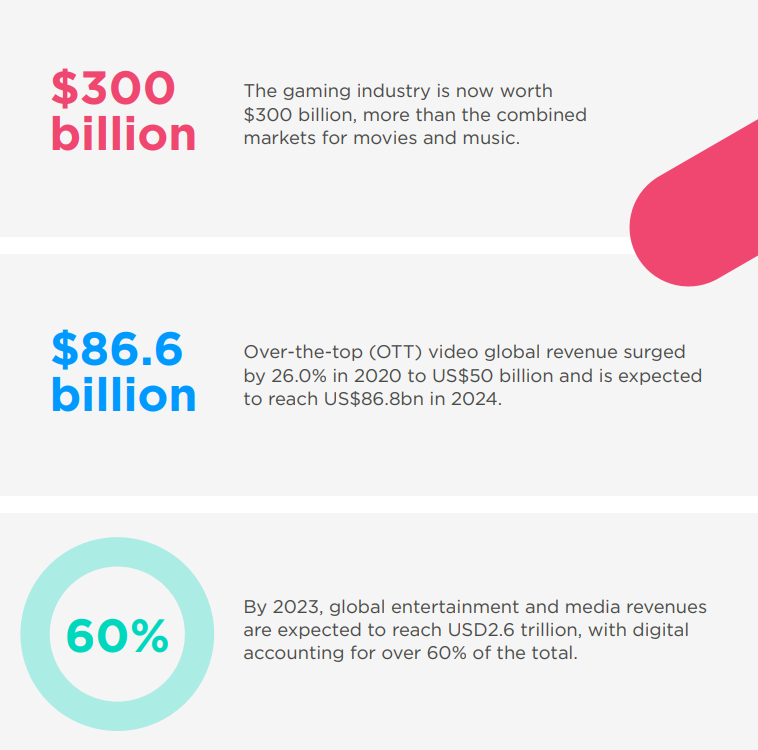Connect media and entertainment to the future
A four-step plan to win the war for customer loyalty with superior digital experiences
The world needs media, entertainment and gaming. The industry needs to innovate faster. Just as Amazon forever raised the customer experience bar for e-commerce, Netflix and other over-the-top (OTT) heavyweights have permanently changed the public’s idea of what digital entertainment should be.
World class digital entertainment services are easy to use, offering smart suggestions and binge-worthy original programming. Users now expect all media, entertainment and gaming to be personalised, moreish, and affordable. Value is especially vital where household incomes have taken a hit. Content producers must offer value for money and immersive new experiences, despite pressures & ferocious competition.
Game on
For traditional companies in film and music, the fact that gaming is now worth more than both combined is a wakeup call to work harder: is it possible to compete, offering experiences that are as immersive, social and multisensory as the top game platforms? Can partnerships be struck that tap into gaming’s reach and pulling power? Media companies must work faster, more collaboratively and more creatively, and that means re-invigorating stalled transformation initiatives. The first step is modernising decades-old infrastructure. It must take priority, because disconnected systems, manual processes and legacy technologies are the biggest impediments to change.

Disconnected systems are a strategic weakness
gility and adaptability are prerequisites for content companies who want to innovate with exciting new experiences, strategic partnerships, and fast, collaborative work methods. But in established companies, customer-facing and internal operations are held back by disconnected infrastructures. These cause a range of problems that make it hard to compete with nimble upstarts:
- System silos inhibit the visibility needed to improve customer service and reduce churn
- Lack of real-time data makes it hard to shift investment priorities quickly
- Ineffective collaboration tools aren’t speeding up content production as they should
- Connectivity isn’t optimised, creating performance issues and security gaps
- Fragmented datasets make it impossible to analyse data at scale and personalise offerings
The connected content provider is battle-ready
The war is raging for consumer attention. When free trials or favourite shows end, users don’t hesitate to drop subscription services. Even where content is sticky, competitors can easily distract users with shiny offerings on a different channel or medium.
The provider who can strike new partnerships, deliver world-class customer service, and bring fresh content to market fast – despite the constraints of pandemic-era production – is best positioned to capture and keep viewers’ attention, and ride the digital media growth wave that’s still rising.
The connected content provider can:
- Delight users with targeted, data-driven content suggestions that keep them loyal
- Deliver multisensory content that leverages augmented and virtual reality and 360° video
- Control costs with real-time business insights that allow rebalancing of investments
- Unify a dispersed workforce with effective collaboration tools that reduce time-to-market
- Protect against cyberattacks with a network that keeps valuable content and user data safe
- Welcome new partnerships and M&A with connected systems that facilitate integration
The four steps to becoming a more connected provider
In the battle for hearts and minds, connectivity isn’t just a weapon, it’s the battleground. To compete and win, providers need to achieve transformation in four key areas:
Innovate with multisensory experiences
Media, entertainment and gaming companies have been trialling innovative, multisensory content, and the pandemic has accelerated the blend of virtual and physical. Robust connectivity is a must- have to maximise these technology-rich opportunities, now and in the near future:
Now
Music and gaming lead in blended experiences. Rapper Travis Scott’s new song hit No. 1 after he launched it via an exclusive VR concert inside Fortnite, where Travis appeared as an avatar. Coachella has pioneered using augmented reality to make images seem to hang in the air when visitors to the music festival point their phones up, driving the need for low-latency connectivity. To boost pre-event buzz, it also sent ticket holders “welcome boxes” to sprang to life with a 3D map of the grounds.
Near future
Virtual overlays on a range of media types can delight fans with content extras, whether home, inside a virtual space or live at a venue. And fan interaction with virtual assets and apps provides behavioural
and preference data to allow better personalisation. The momentum is toward more virtualisation, especially as 5G opens new doors: recording artists could make live virtual appearances, with zero latency, in multiple locations at once.
Needs
The right connectivity partner can help you prepare to deliver richer content with:
- A managed enterprise network with high bandwidth and end-to-end security
- Ultra-low latency connectivity for real-time broadcasts
- Rapidly scalable cloud resources for spikes in user demand
- Scalable data mining tools and AI to build user profiles for personalisation
